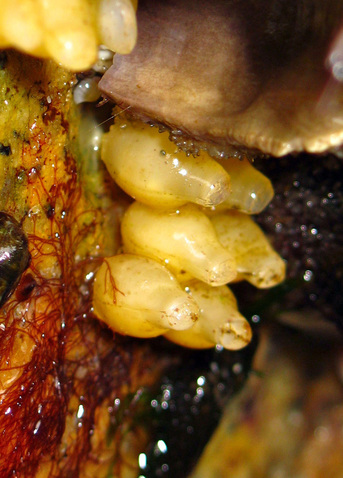Sea grapes, yellow social tunicate • Perophora annectens
|
Identification
Sea grapes are small tunicates that grow in colonies. They have the general appearance of very small and elongated green grapes, with a somewhat globular shape and a translucent yellow-green colour. Individuals get to 6 cm tall and 2-3 mm wide. They may grow separately or attached by threat-like pieces of tissue (stolons). Their colour, small size, and rounded shape make them fairly distinctive. Habitat & Range Sea grapes grow on rocks, algae, and floats from the low tide line to 30 m deep. They are most common along open coastlines or in areas with currents. Their range extends from southern Alaska to southern California. Intriguing Info Tunicate hearts can pump in both directions. The translucent nature of sea grapes' bodies makes them useful for studying the inner workings of a tunicate, including heartbeat and blood flow. |
References
Cowles, D. (2009). Perophora annectens Ritter, 1893. Invertebrates of the Salish Sea. Rosario Beach Marine Laboratory. Accessed 03/11/2014.
Harbo, R. M. (1999). Whelks to whales: Coastal marine life of the Pacific Northwest. Madeira Park, BC: Harbour Publishing. P. 154.
Lamb, A., and Hanby, B. (2005). Marine Life of the Pacific Northwest [electronic version]. Madeira Park, BC: Harbour Publishing.
Authors and editors of page
Kelly Fretwell and Brian Starzomski (2014).
Cowles, D. (2009). Perophora annectens Ritter, 1893. Invertebrates of the Salish Sea. Rosario Beach Marine Laboratory. Accessed 03/11/2014.
Harbo, R. M. (1999). Whelks to whales: Coastal marine life of the Pacific Northwest. Madeira Park, BC: Harbour Publishing. P. 154.
Lamb, A., and Hanby, B. (2005). Marine Life of the Pacific Northwest [electronic version]. Madeira Park, BC: Harbour Publishing.
Authors and editors of page
Kelly Fretwell and Brian Starzomski (2014).





